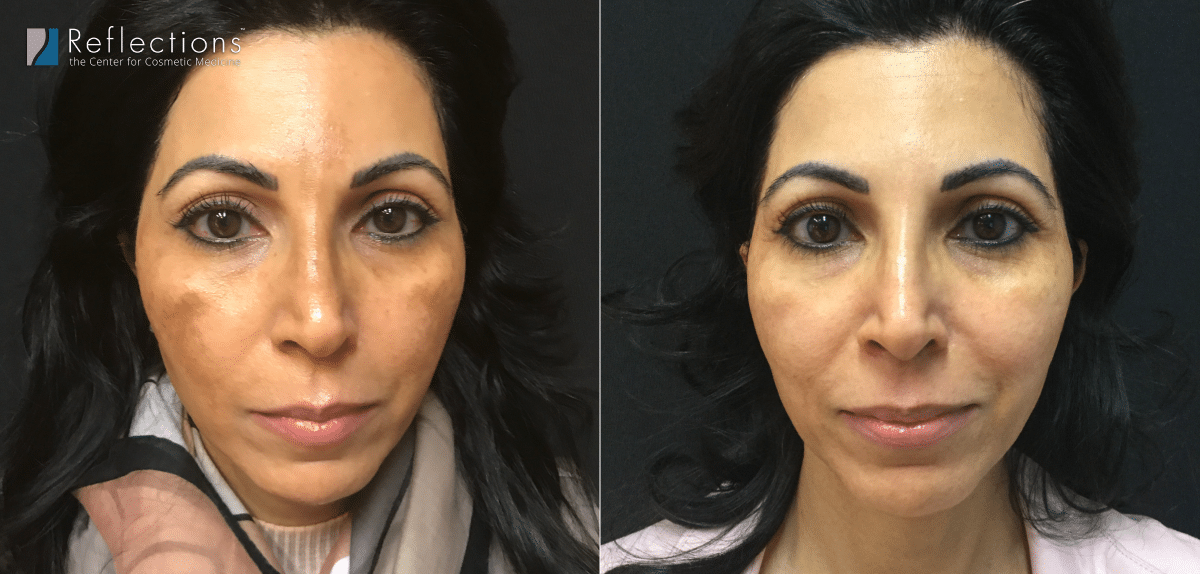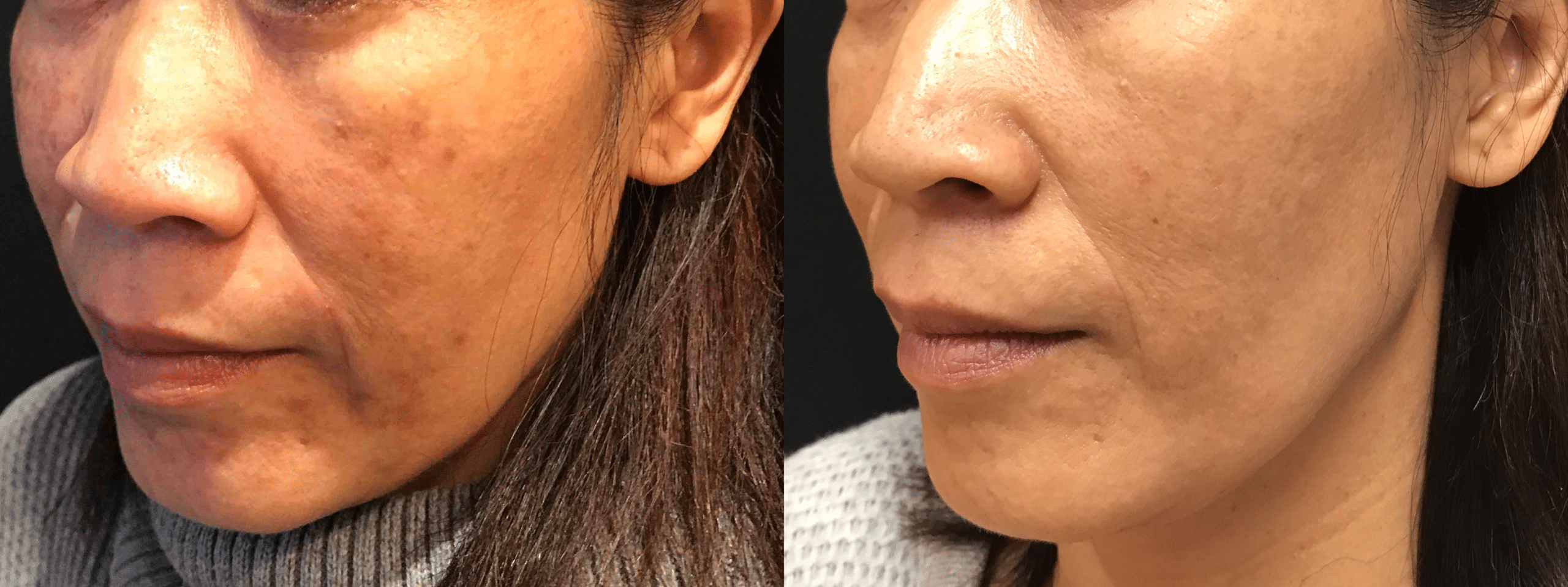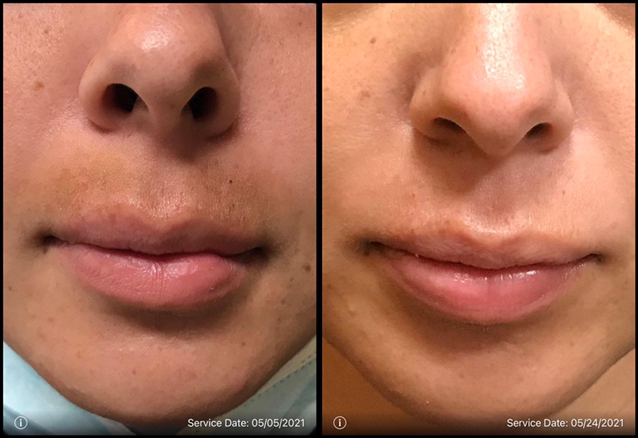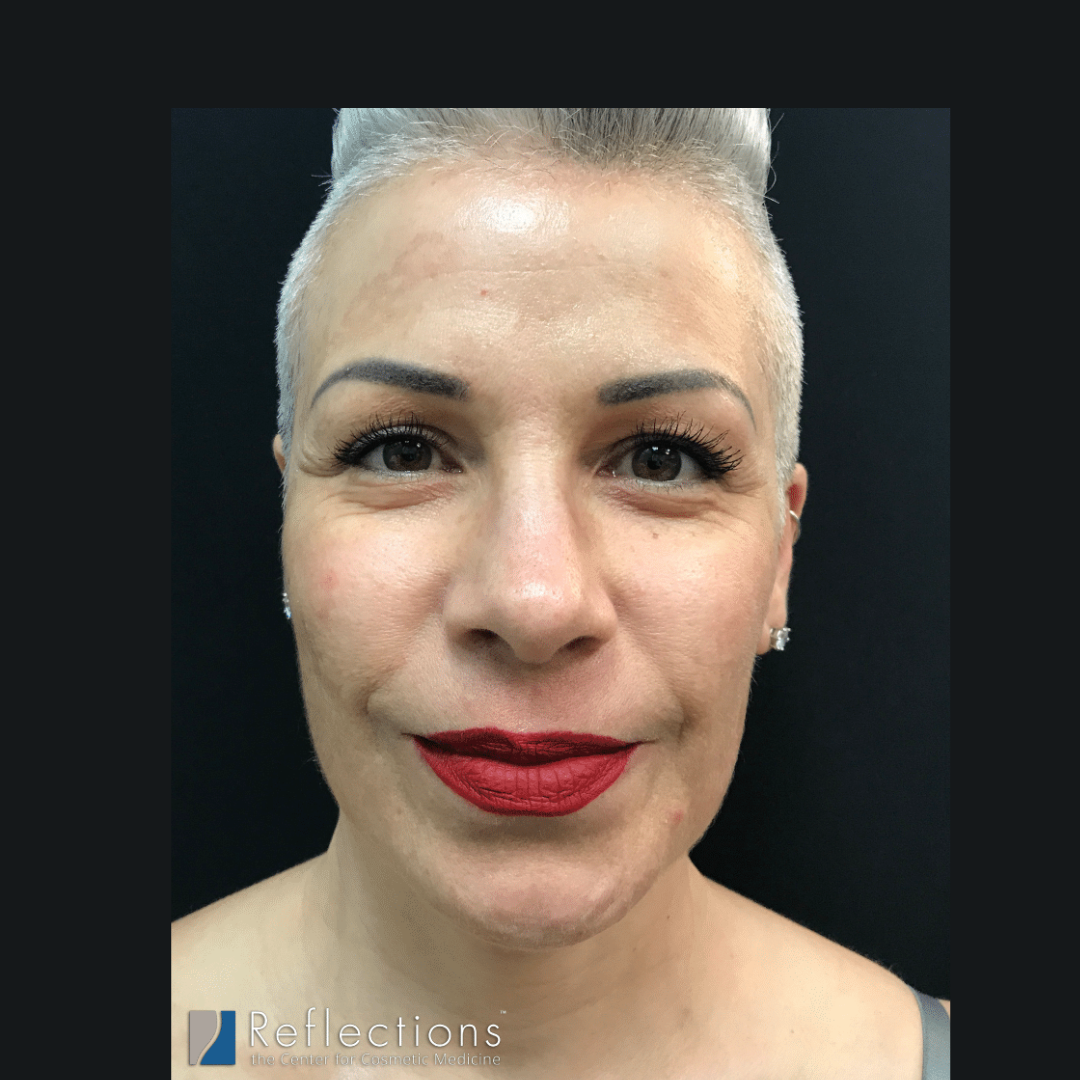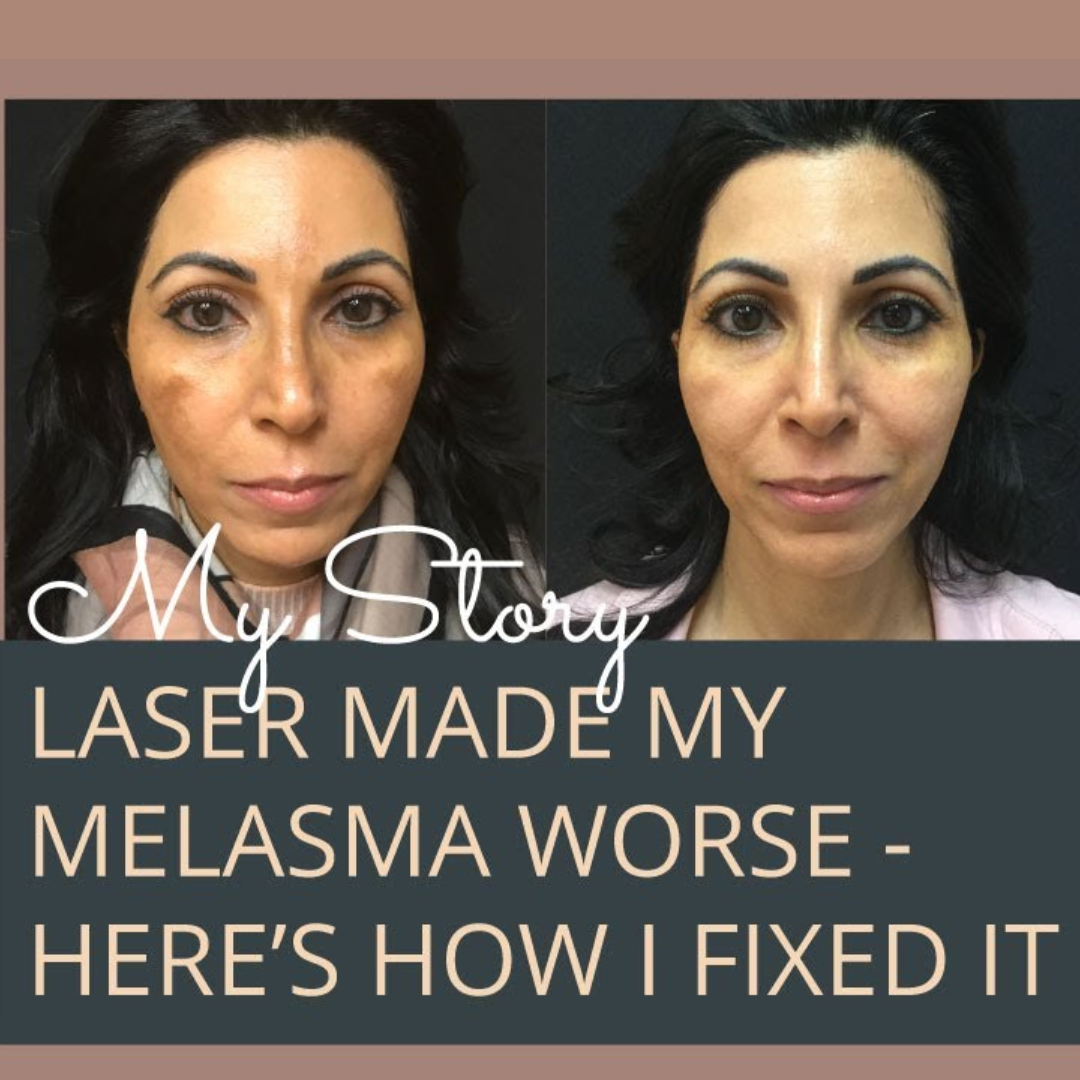Have pregnancy, birth control pills, or heredity left you with brown patches of uneven-toned skin? You are not alone — an estimated six million American women live with melasma, a condition in which brown pigmentation (melanin) appears on the face, and can even create a mask-like appearance. For many patients, melasma can cause a loss of confidence and even anxiety or depression.
Top Asked Questions About Melasma
- I have melasma. Can I still spend time outside?
At Reflections, we want to help you look and feel your best, and that means being able to do the things you love. As part of your treatment plan, our team will recommend a top-grade sunblock for daily protection and strategize with you about other ways to protect your skin from the sun and keep melasma from reappearing.
- What is the best way to treat melasma?
The best way to treat melasma depends upon the individual, but all treatment needs to include both active treatments to remove the pigment in the skin and a proactive skincare and medication routine to prevent new pigment from developing. An example of this might be Clear + Brilliant laser treatment to remove the spots you have, plus tranexamic acid prescription to use everyday, plus sunscreen used daily.
- Can melasma be cured permanently?
No - currently melasma cannot be cured. However, we can usually manage it with ease when patients are consistent with their prevention using medications and skincare at home.
What Causes Melasma?
Melasma is a chronic condition that is affected by hormonal fluctuations. Most women notice melasma is triggered when they undergo a large fluctuation in hormones from pregnancy, the use of birth control pills, or hormone replacement therapy. It also seems to run in families and is more prevalent among Latina and Asian women.
What are the Best Treatments for Melasma?
Melasma can be a difficult condition to treat, and using the wrong device for your particular type of melasma can actually make the condition worse. This is why it’s important to choose a physician who is experienced in treating all forms of melasma and has invested in a variety of laser technologies to address the condition.
It’s fairly rare these days to find a physician who is both willing to take the time to evaluate what’s going on with you medically that’s causing your melasma and write the prescriptions to manage that, and who has invested in all the technologies it takes to treat melasma well across various skin types and variations in expression of this skin condition. The right tools in experienced hands make all the difference in the world when it comes to treating your melasma.
Our treatments focus on two goals:
- Reducing the creation of new pigment – this can be achieved with skincare, sun protection, and prescription medications (often we recommend a prescription as part of your skincare routine, and sometimes we also use pills)
- We reduce and eliminate the existing pigment – this is the harder part because it really requires the provider to understand the depth within the skin that current pigment exists, and that they understand how to do so without triggering more pigment (since we’re often using lasers, and intense heat is a trigger for melasma).

Everyone Needs Great Prevention of Future Melasma Pigment
We mentioned above that melasma is chronic, meaning there is no known cure and it will continue to return throughout your life. Prevention is key – but it won’t guarantee that you never have any issues again. You’re very likely to see melasma flare up anytime there are hormonal fluctuations, as well as any time you get sun exposure or are in the heat – both sun exposure and heat are big triggers for melasma.
Sunscreen should ideally be a physical blocker, as opposed to chemical sunscreen. Chemical sunscreen has been linked with cancer in some studies and is terrible for our oceans. Physical sunscreens contain zinc or titanium dioxide, and the best ones contain both because each blocks a different part of the sunlight spectrum. Newer formulations of physical sunscreens don’t leave you white and pasty anymore. We sell EltaMD in our offices, but you can also find other reputable brands in Sephora and Ulta, like Supergoop.
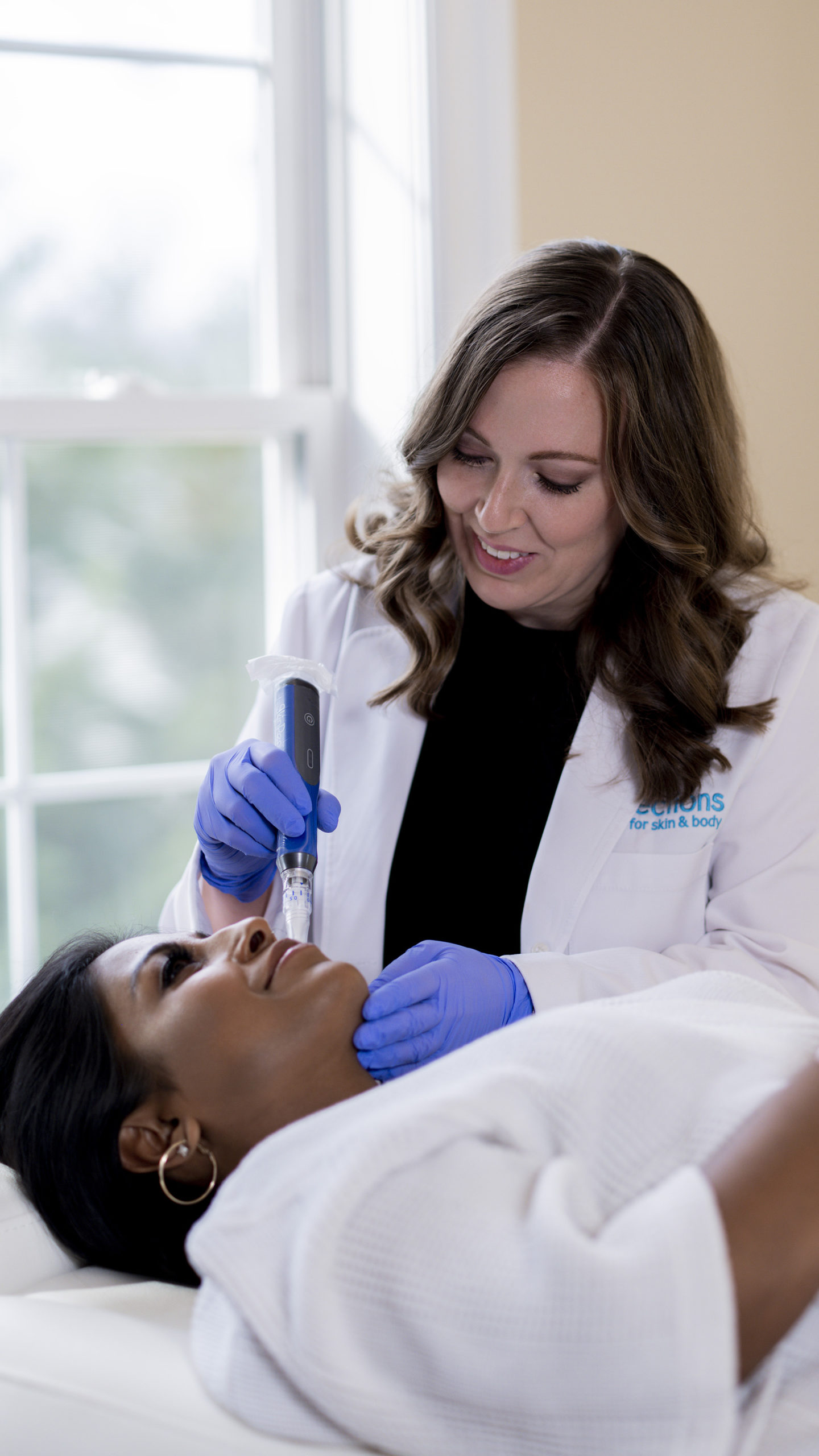
Topical Creams & Prescriptions for Melasma
This is where everyone should start in treating melasma and for some women, especially those who treat it as early as possible (although not during pregnancy or breastfeeding, please), these treatments may help get existing pigmentation cleared up.
We often recommend combining your laser treatment with topical medications such as hydroquinone 4 – 12% (we sell this in our office), retinoids such as Retin-A (we are happy to write you a prescription), or a prescription cream known as Tri-Luma® Cream.
Agents such as hydroquinone do not “bleach” the skin, but instead decrease the activity of the melanin where applied. Retinoids promote the rapid loss of pigment by increasing skin turnover and easing penetration of helpful topical ingredients into the skin. Because hydroquinone decreases melanin in the skin, it often reduces the appearance of melasma.
The doctor may also add a corticosteroid cream or a product called tretinoin which can speed up the lightening of the melasma. While this works for some women, those with more persistent melasma will likely not be satisfied with the results they get when using topicals alone.
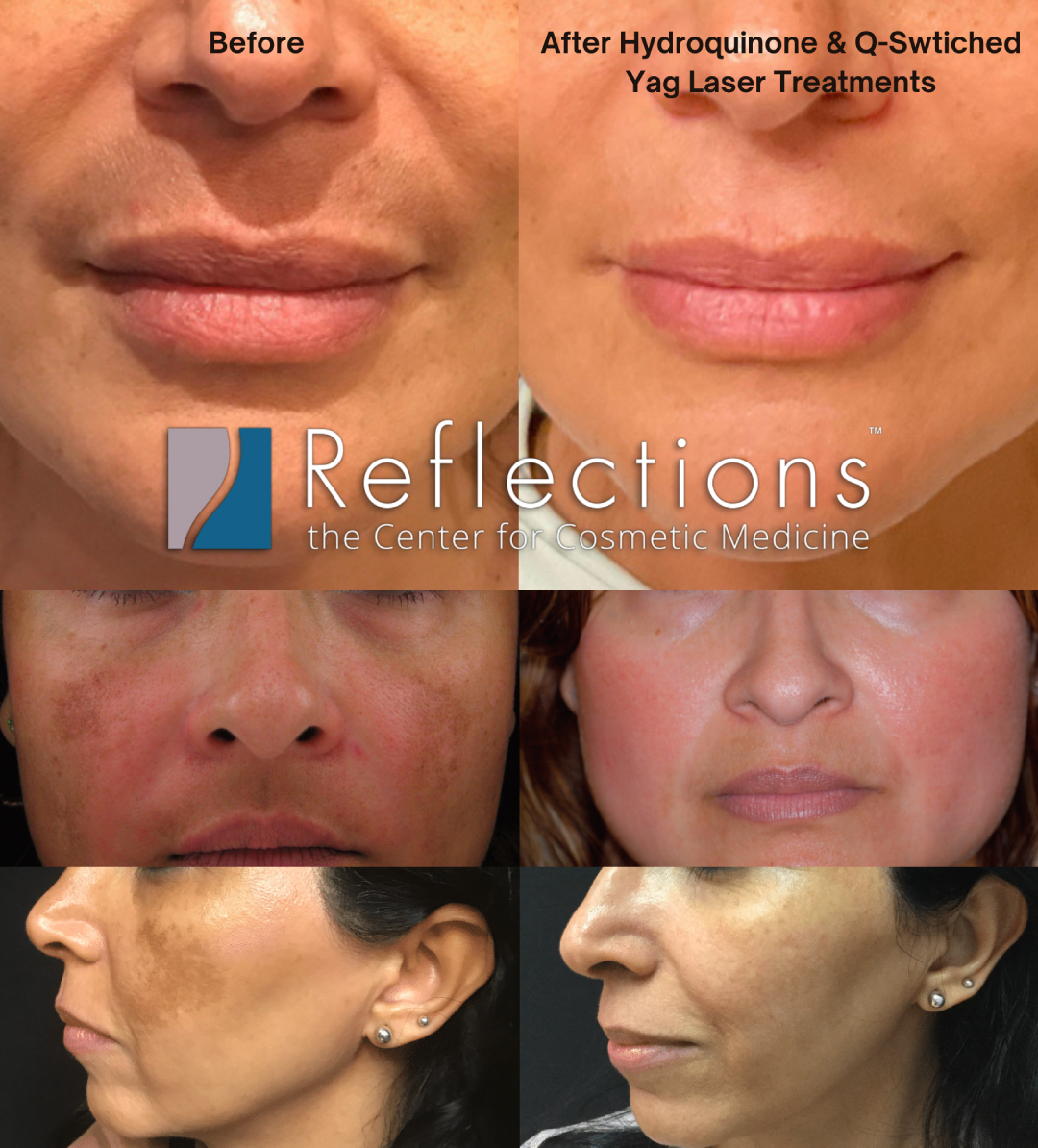
Removing Existing, Stubborn Spots
While microdermabrasion, microneedling, and chemical peels can also be used for treating melasma, we have found that lasers make for the best melasma treatment.
Clear + Brilliant Laser
Clear + Brilliant is the latest innovation in fighting melasma. This laser treatment penetrates the skin at a shallow depth, targeting the layers where much of the unwanted pigment from melasma resides. Clear + Brilliant is a good choice for both initial treatments and maintenance therapy, with treatments usually spaced about one month apart4. However, this treatment is not appropriate for patients with dark skin tones.
Fraxel Re:Store Dual Laser
For the more aggressive treatment of melasma there’s the Fraxel Re:Store Dual laser, which is the gold standard for sun-damaged skin. Its energy penetrates deep into the skin, eliminating the skin cells that cause melasma while protecting the skin’s outer layer. Fraxel Re:Store Dual laser treatments are usually performed monthly for a three- or four-month period3. However, this treatment is not appropriate for patients with dark skin tones.
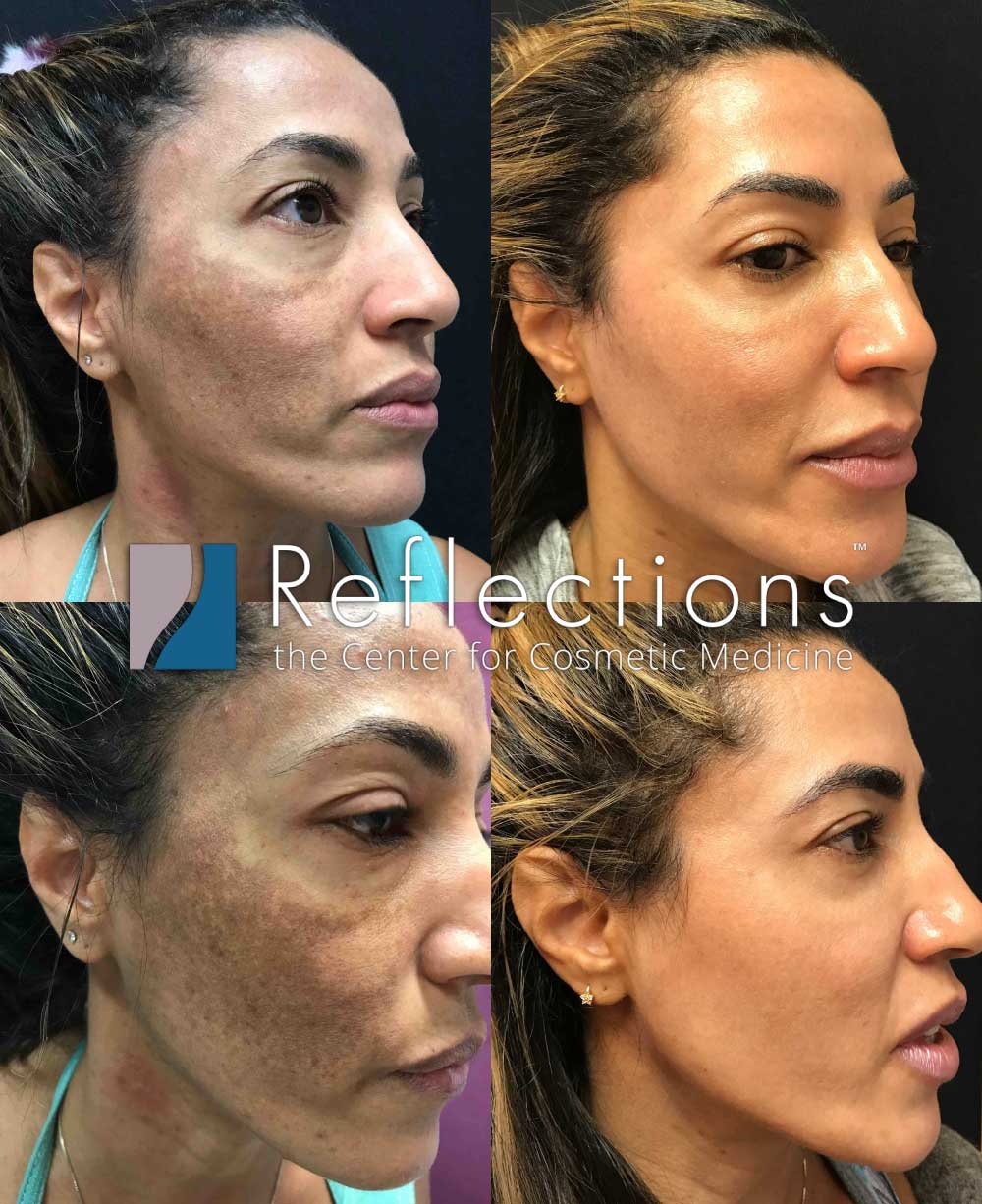
Q-Switched Nd:Yag
The Q-Switched Nd:YAG laser can target melanin in the deep dermis, making it another option for the treatment of melasma. This laser is especially useful when treating patients with darker skin, as its long wavelength provides a safer and more effective treatment. Q-Switched Nd:YAG treatments are usually provided in a series of visits, spaced two to three weeks apart, and are often used to supplement the great results from Clear + Brilliant and the Fraxel Re:Store Dual laser1. This laser is safe for all skin types.
Intense Pulsed Light (IPL)
Intense pulsed light (IPL) treatments can also be helpful in some cases where the pigment from melasma is found in the epidermis, the upper most layer of the skin2. Unfortunately, what we often see is patients with skin of color who were mistreated with this modality and whose melasma has been made worse. This is the treatment we use the least because it’s only appropriate for a very small percentage of patients – but unfortunately, it’s a cheaper system to buy and it’s widely misused in other practices.
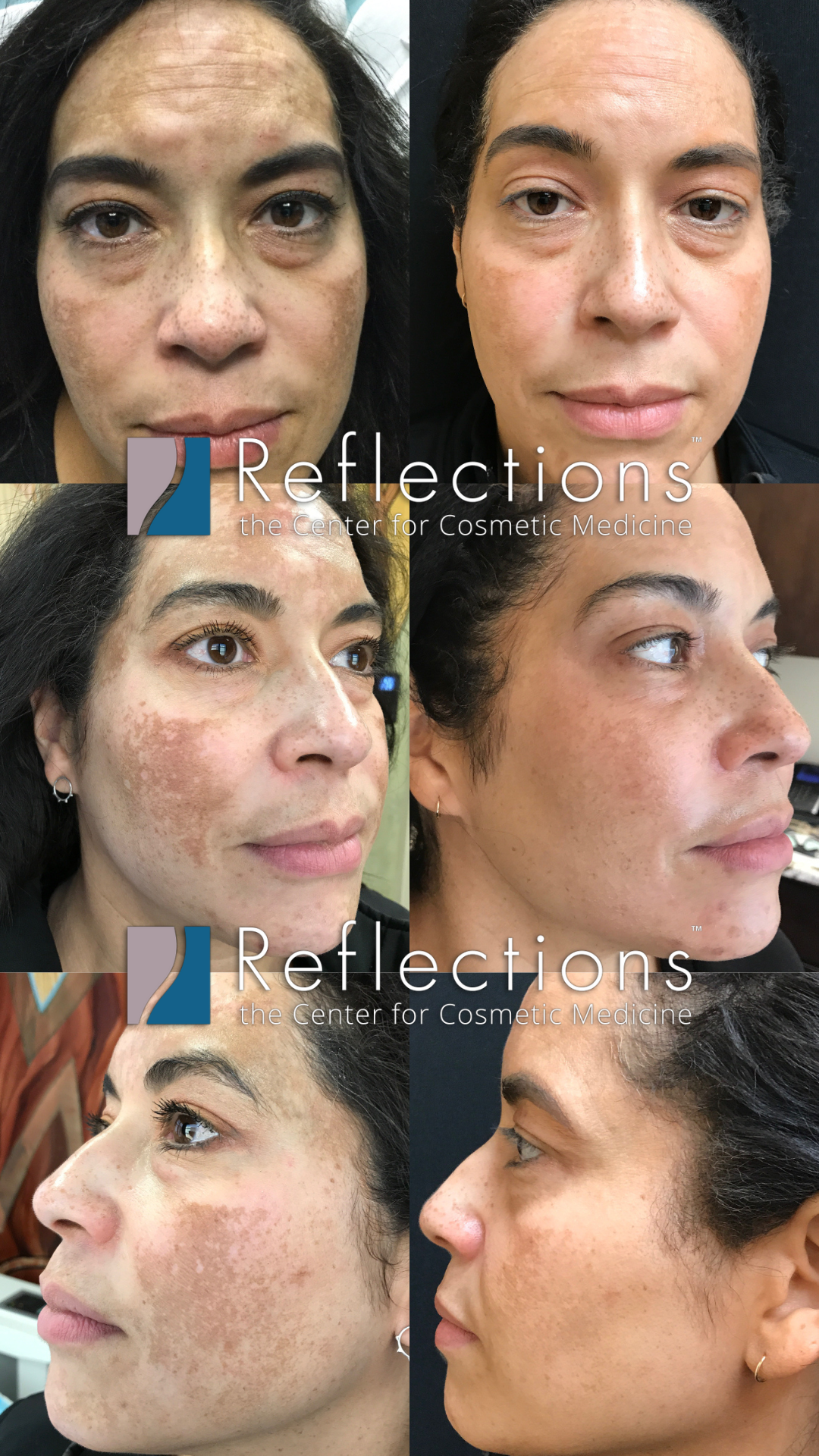
Tranexamic Acid Pills or Micro-Injections – Not the Creams and Serums!
Tranexamic Acid (TXA or TA) is a god-send for patients with the most stubborn melasma. A 12 week course of this prescription medication pill has cleared away melasma for our patients that lasers and other medications have not been able to.
However, this medication is a pill, which means it goes throughout your entire body and it is a medication that can create some problems for certain patients, so it’s not something to take lightly. We reserve it for patients with the most severe and stubborn cases of melasma who have failed other treatments, and who our doctors can clear medically.
We are aware there are a host of new skincare products that have topical tranexamic acid in them. TXA is a big molecule and cannot make it to the melanocytes deep within your skin through a topical. Unfortunately, these skincare products with tranexamic acid are a waste of money.
We also offer a micro-injection treatment with TXA – like microneedling, but with medicine being delivered through those needles – so that the TXA is not going throughout your entire system, but can reach the right depths for effective treatment. We call this treatment TXA Restore.
Learn More About Tranexamic Acid TreatmentCompare the Best Melasma Treatments
Fortunately, there are several ways of treating melasma, starting with topical treatments, chemical peels, and microdermabrasion, and usually ending with cosmetic lasers. So even if you’ve tried treatments in the past and not gotten the full results you’re after – and especially if any treatment you’ve had has made your melasma worse – we’ve got the physicians and the treatments to help you turn it around and get your melasma under control. This is a specific condition that we have invested very heavily in being able to provide the very pinnacle of care for because we know how emotional and upsetting it is.
| Treatment | Cost | Invasiveness | Downtime | How it Works |
|---|---|---|---|---|
| IPL (Intense Pulsed Light Therapy) | $300 - $450 Per treatment, multiple sessions recommended Reduced package pricing available | Low-mid intensity pulsed light treatment. No anesthetic required | Mild redness the evening of treatment, but no true downtime | Targets dark spots by selectively heating them. Not applicable for darker skin types |
| Clear and Brilliant Laser | $475 - $825 Per treatment, multiple sessions recommended Reduced package pricing available | Low-intensity laser with topical numbing cream used | Redness the evening of treatment, but no true downtime | Targets dark spots by selectively heating them, not applicable for darkest skin types |
| Q Switched Yag Laser | $300 - $450 Per treatment, multiple sessions recommended Reduced package pricing available | Medium intensity laser. No anesthetic required | Mild redness which quickly resolves, no scabbing or crusting. No downtime. | Targets and reduces dark spots by selectively heating them. Safe for all skin types, even darker skin |
| TXA Restore™ (Micro-injected Tranexamic Acid) | $900 per treatment | Micro-injection treatment with injection numbing used (expect pinpoint bleeding during procedure) | Redness and mild swelling for few days, coverable by makeup. Potential for bruising | Tranexamic acid acts to inhibit pigment production and directly on blood vessels in a way to inhibit melasma |
| Fraxel Restore Dual Laser | $450 - $900 Per treatment, multiple sessions recommended Reduced package pricing available | Medium intensity laser with topical numbing cream used | Redness for few days, coverable by makeup. Flaking for several days | Targets and reduces dark spots by selectively heating them |
| Microneedling Dermapen | $950 - $1400 Per treatment, sometimes, concentrated platelet solutions are added to procedure. Multiple sessions recommended Reduced package pricing available | Low depth microneedling | Some minor redness, coverable with makeup | Microneedling initiates healing mechanisms that improve pigmentaion in skin |
| Chemical Peels | $150 - $250 Per treatment, multiple sessions recommended Reduced package pricing available | Low-strength chemical peel | Minimal to no downtime | Topical agent causes shedding of upper layer of skin |
Prescription Medications |
Varies, depending upon your insurance coverage and pharmacy pricing | Pills and topical/skincare options available | No downtime | Most patients will need topical agents to maintain results from treatments and help reduce future flare ups |

View More Melasma
Before and Afters
More Before & Afters


Choose Reflections Center as Your Melasma Treatment Specialists
With Reflections’ approach to melasma treatment and management, you will look like yourself again. Best of all, you’ll have a new confidence when you’re out and about, knowing everyone can see the real you.
Prescribing the right combination of medications and lasers is critical to successful melasma treatment. Therefore, it is critical to choose a physician who has the complete array of laser technologies for melasma treatment that is best for your particular type of melasma. It’s also important to choose a physician that has lots of experience treating melasma with lasers, as being too aggressive can often make the condition worse. Please give us a call if you have questions about the best way to approach treating your melasma – consultations are complimentary, and our physicians are always happy to help!
*Results may vary: Melasma is hormone-related and can be resistant to treatment. Usually, patients can expect to see a dramatic improvement in skin tone after laser therapy, but there may be need for additional future treatments, particularly if hormones fluctuate in the future such as with an additional pregnancy.
Frequently Asked Questions About Melasma Treatment
- Which vitamin is good for melasma?
Vitamin C can be good for certain people with melasma. It’s not going to be sufficient on its own, and you need to really take sun protection seriously when you use Vitamin C, especially as sun exposure will darken melasma.
- How can I get rid of melasma naturally?
Naturally means something different to each person. But usually our patients who ask about natural remedies are looking to avoid systemic medications. For melasma, that means laser treatments and natural skincare routine, and good sun protection (which can be a mineral sunscreen or even UPF clothing).
- Which cream is best for melasma?
Over-the-counter creams and skincare work better for preventative maintenance than for removing dark spots. But when we talk about ingredients in creams that are good for melasma, we like to look for one or more of these ingredients: tranexamic acid, vitamin C, and hydroquinone. Sunscreen will also be critical in keeping melasma from darkening.
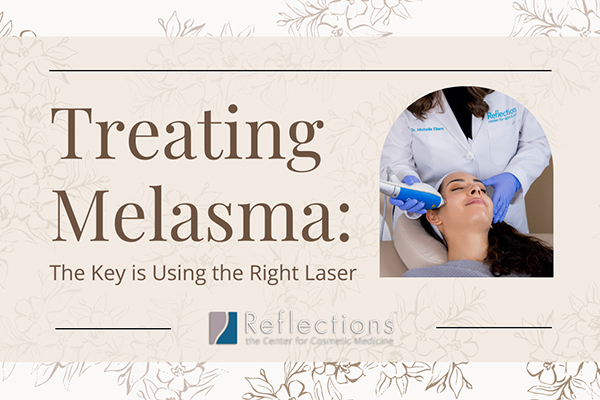
Blog
Treating Melasma: The Key is Using the Right Laser
Please give us a call if you have questions about the best way to approach...
Read More
Blog
Myth: Laser Treatment is for Light Skin Only
It is a popular misconception that cosmetic laser and light therapies are not...
Read MoreSchedule Your Free Consultation
With One Of Our Physicians
Schedule Now
Sources:
- TSE, Y., LEVINE, V. J., MCCLAIN, S. A. and ASHINOFF, R. (1994), The Removal of Cutaneous Pigmented Lesions with the Q-switched Ruby Laser and the Q-switched Neodymium: Yttrium-Aluminum-Garnet Laser. The Journal of Dermatologic Surgery and Oncology, 20: 795–800. doi: 10.1111/j.1524-4725.1994.tb03707.
- Babilas, P., Schreml, S., Szeimies, R.-M. and Landthaler, M. (2010), Intense pulsed light (IPL): A review. Lasers Surg. Med., 42: 93–104. doi: 10.1002/lsm.20877
- Lawrence S. Bass MD; Rejuvenation of the Aging Face Using Fraxel Laser Treatment; DOI: http://dx.doi.org/10.1016/j.asj.2005.03.003 307-309 First published online: 1 May 2005
- Amir M Karam, Mitchel P Goldman; Rejuvenation of the Aging Face; JP Medical Ltd, Aug 28, 2015; pages 91-104

Dr. Mitchell Chasin is a Cosmetic & Laser Physician at Reflections Center. Dr. Chasin believes strongly that the best cosmetic physicians are those who are dedicated to mastering their craft through continuing education and collaboration with the industry’s top doctors.




